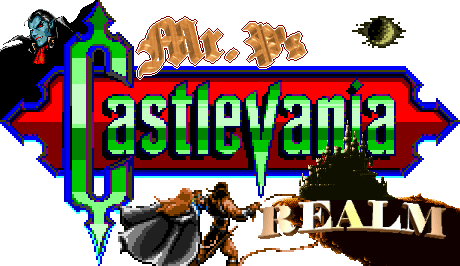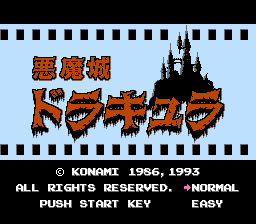
|
American Logo
|
 |
Japanese Logo
|
 |
 |
|
|
|
|
| . | . | . | ||
|
General
Information
|
||||
|
|
||||
| Date Released: 1987 |
|
Heroes: Simon Belmont | ||
|
|
||||
| Stage Number: 6 (18) |
|
Size: 128KB | ||
|
|
||||
|
Original
System(s)
Nintendo Entertainment System (NES) |
||||
|
|
||||
|
Ported
To
Commodore 64 | IBM PC | Amiga Home Computer | Arcade | PC | Cell Phones | GBA | GameTap (download service) | Nintendo Wii (Virtual Console) |
||||
|
.......................... .Alternate
Names/Systems
(1) Famicom Disk System: Akumajou Dracula -- translation: Demon Castle Dracula (2) Famicom: Akumajou Dracula -- translation: Demon Castle Dracula (3) Arcade: VS. Castlevania |
||||
|
|
||||
|
Re-release Information (1) 1990: The
game sees three different re-releases for three separate computer systems:
The Commodore 64, the Amiga Home Computer, and the IBM PC (for information
as to their availability, click here) |
||||
|
|
||||
|
Manual Story Description GOOD
EEEEVENING |
||||
|
|
||||
|
Objective/Overview Castlevania was the first series' title available to the western world, and, in retrospect, it still reigns as one of the supreme efforts of its time. Its origin is directly correlated to Vampire Killer, the Konami-made adventure for the MSX2 Home Computer. There are many arguments as to which came first in Japan--Vampire Killer or Akumajou Dracula--but it's of no consequence here because of the one-year gap between western localization. The objective of the game is for the hero, the whip-toting Simon Belmont, to fight his way through six torturous stages filled with evil monsters and devious traps and resided over by the dreaded boss characters--the last of which is the ultimate evil of this game's universe, the vampire Count Dracula. By clearing the game and waiting through the credits, you you can resume play in a sort-of "second quest," a more difficult mission highlighted by an increased amount of sometimes speedy minor enemies. The gameplay is similar in mechanics for all of the alternate versions (mainly those played on computers), however watered-down each may be. The difficulty of each is increased due to very poor control schemes, maddening design, and other computer limitations. In the early 90's, the Castlevania showed up in arcades as part of Nintendo's Player's Choice series; a future arcade port, VS. Castlevania, featured two-player (taking turns, not co-op) action for the quarter-spending masses. Click on "review" at the bottom of this page for more information. |
||||
|
|
||||
|
Japanese/European Differences Two Japanese versions exist with minor differences: First, there's the original Akumajou Dracula made for the Famicom Disk System in 1986; this version has a name-entry option (featuring the game's one unique music track) that allows you to save your game into a slot and thus the game's memory--something inexplicably missing from the U.S. version, if you ask me. Also, it features some different layouts in terms of candelabras, as seen in the anomaly depicted in the animated screenshot, and thus the power-up system controlled therein. For instance: Simon can collect morning-star symbols much earlier than normal, where he usually has to attain five hearts beforehand. Then there's the catridge-based version that Konami released years later in 1993. In this version, you can select a "normal" or "easy" difficulty. There are two other minor differences here: (1) Strangely, when you complete a stage, the heart meter drains more rapidly for only a smaller boost to your point-total, and (2) it has added to its presentation a Konami-logo pre-title screen. Overall, both iterations are less difficult to conquer than the NES version. Also, as it is in the case of all the Japanese titles, the hero's last name is "Belmondo" rather than "Belmont." (Thanks to Danny for some of this information.) |
||||
|
Soundtrack and Credits Soundtrack Links |
||||
|
|
||||
|
Other Characters Lesser Enemies:
Skeleton, Zombie, Vampire Bat, Fishman, Knight, Medusa Head, Hunchback,
Skeledragon, Red Skeleton, Ghost, Eagle, Raven, Leopard, Pillar of Bones
and Axe Knight |
||||
|
|
||||
|
Character Lists |
||||
| . | . | . | ||
![]()
Main Arsenal
|
Hero
Image
|
Statistics
|
|
|
|
Full Name: Simon Belmont | |
| Main Weapon: Vampire Killer Whip | ||
| Weapon Power-Up: Chain Whip & Morning Star Whip | ||
| Alternate Weapons: None | ||
| Sub-Weapon Power-Up: Double and Triple Shots | ||
| Special Abilities: None | ||
| Armor: None | ||
| Limitations: Castlevania's version of Simon Belmont is the prototype for which most others follow. Simon is rather plodding in the way he moves, and he climbs stairways at a pretty slow rate. He cannot redirect his jumps while in the air, so when a direction is chosen for a respective jump, it to one he must be committed. While on stairs, in motion, or in mid-jump, enemy contact will send him flying. While the leather whip is insufficient for fending off multiple enemies, the chain whip and the morning star version of the Vampire Killer will allow him to move along quickly while plowing through enemy onslaughts; however, Simon will have to rely heavily on sub-weapons if he hopes to defeat the toughest of boss creatures. |
|
Weapon
Name
|
Weapon
Image
|
Description
|
|
Vampire
Killer
|
|
Standard
family-created leather whip
|
|
Chain
Whip
|
|
Steel-enhanced
short-length whip
|
|
Morning
Star
|
|
Longer,
stronger chain whip
|
![]()
|
Magical
Items
|
|||
|
Item Name
|
Image
|
Found In
|
Usage
|
|
Morning Star
|
|
Candle, Enemy
|
Whip Power-Up
|
|
Heart
|
|
Candle, Enemy
|
Powers Mystic Weapons
|
|
Big Heart
|
|
Candle, Enemy, Wall
|
Powers Mystic Weapons
|
|
Invisibility Potion
|
|
Candle, Enemy
|
Renders Invincible
|
|
Rosary
|
|
Candle, Enemy
|
Clears Screen of
All Enemies
|
|
Money Bag
|
|
Candle, Enemy, Wall
|
Adds to Point Total
|
|
Crown
|
|
Hidden in Surroundings
|
Adds to Point Total
|
|
Treasure Chest
|
|
Hidden in Surroundings
|
Adds to Point Total
|
|
Moaui Head
|
|
Hidden in Surroundings
|
Adds to Point Total
|
|
Double Shot
|
|
Candle, Enemy, Wall
|
Throws Two of One
Weapon
|
|
Triple Shot
|
|
Candle, Enemy
|
Throws Three
of One Weapon
|
|
Pot Roast
|
|
Wall
|
Restores Energy
|
|
One-up
|
|
Hidden in Surroundings
|
Adds One Life to
Your Stock
|
|
Crystal
|
|
Boss Creature
|
Clears Stage of
All Evil
|
|
Sub-Weapons
|
|||
|
Weapon
Name
|
Image
|
Heart Consumption
|
Comments
|
|
Dagger
|
|
One
|
-
|
|
Holy Water
|
|
One
|
-
|
|
Boomerang
|
|
One
|
-
|
|
Axe
|
|
One
|
-
|
|
Stopwatch
|
|
Five
|
-
|
![]()
Screenshots & Media
Local Title Screens
 |
 |
|
U.S.
Title Screen
|
.
|
Japanese Title
Screen (FDS)
|
 |
 |
|
Japanese
Title Screen (Famicom)
|
.
|
European Title
Screen
|
Action Shots














|
Alternate-Version
Screenshots
|
||
|
Computer
Versions
|
Arcade
Versions
|
Other Versions
|
|
-
|
||
|
Quick-Reference
Links
|
||
|
Category
|
Availability
|
What's
Inside
|
|
Stages:
|
Six-stage
review with complete stage maps
|
|
|
Review:
|
Overall view
of the game, its origin and its ports
|
|
|
Codes:
|
Hidden treasures
| The Holy Water trick
|
|
|
Magazine
Coverage
|
|
|
Item Name
|
Description
|
|
Shown for this "perfect"
strategy guide are its covers and select page samples
|
|
|
Coverage includes
an overview and four pages of detailed stage maps
|
|
|
Provided are complete
stage maps, item locations and boss strategies
|
|
|
IGA reveals the
FDS game to be the series' origin (scans by JPCVFAN)
|
|
Text Documents
and Help Files
|
||
|
Walkthroughs
|
FAQs
|
Other Files
|
|
-
|
||
|
-
|
-
|
|
|
-
|
-
|
|
|
Scenes,
Packaging Scans and More
|
||
|
American
Version
|
Japanese
Version
|
European
Version
|
|
-
|
||
|
-
|
||
|
-
|
||
|
-
|
-
|
|
|
-
|
-
|
|
|
-
|
-
|
|
|
-
|
-
|
|
|
-
|
-
|
|
|
-
|
-
|
|
|
-
|
-
|
|
|
-
|
-
|
|
|
-
|
-
|
|
|
-
|
-
|
|
|
-
|
-
|
|
|
-
|
-
|
|
|
[Home] [What's New?] [CV Library] [Stages] [Reviews] [Weapons] [Castleography] [Multimedia] [Codes] [Links] |
||||